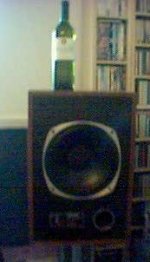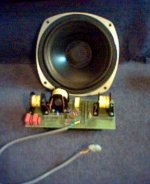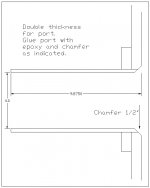I found aprogram called WinISD but am having a few probs.
I have the Tannoys on top of Pardington Dreadnoughts at the moment and the high driver is right on ear level. I want a floor standing box that is a narrow as possible, maybe just wider than the driver.
If the volume is too great then I would put a false bottom in to reduce the cabinet size.
I am not sure if vented or sealed (IB?) would be best. From my understanding a large-ish sealed cabinet would be great for tight bass. Why vented Luke123?
I will measure the vent in the cabinet tommorow as I am house/granny sitting this week
I have the Tannoys on top of Pardington Dreadnoughts at the moment and the high driver is right on ear level. I want a floor standing box that is a narrow as possible, maybe just wider than the driver.
If the volume is too great then I would put a false bottom in to reduce the cabinet size.
I am not sure if vented or sealed (IB?) would be best. From my understanding a large-ish sealed cabinet would be great for tight bass. Why vented Luke123?
I will measure the vent in the cabinet tommorow as I am house/granny sitting this week
 here they are!!
here they are!!the serial numbers are 2528/004059 and 2528/004079
The 2528 is the diameter.
The surrounding metalwork os exactly 10inches across. The port is 2.5 inches wide and 51/8th inches deep and it feels like the damping material is almost solid!
Luke 123 any help would be much appreciated with the cabinet design. I would like to try transverse lamination for a nice curved cab. I beleive that my speaker is the second of the three tech specs you sent.
Attachments
Well James, if Dave drools over the 10" drivers then this should be a worthwhile project. I have some questions:
What condition are these drivers in - cone and surround?
Has anyone calculated the closed box volume for a Q of around 0.7 yet? Maybe Luke123 could tell us how close that is to the current volume.
Have you tried stuffing socks into the port to approximate to what a sealed box of the current volume would sound like?
Incidentally, I think that the volume of 49 litres that you mentioned is the external volume. You need to know the thickness of the cabinet walls to work out the internal volume (which is the one we calculate by).
A taller, narrower floorstander using a translam construction sounds cool to me.
Later
Steve
What condition are these drivers in - cone and surround?
Has anyone calculated the closed box volume for a Q of around 0.7 yet? Maybe Luke123 could tell us how close that is to the current volume.
Have you tried stuffing socks into the port to approximate to what a sealed box of the current volume would sound like?
Incidentally, I think that the volume of 49 litres that you mentioned is the external volume. You need to know the thickness of the cabinet walls to work out the internal volume (which is the one we calculate by).
A taller, narrower floorstander using a translam construction sounds cool to me.
Later
Steve
7v
Thanks for replying!
Looks like I'm gonna have to stop listening to 'em and crack one open. I'll try and do this on Monday as its my 2nd wedding anniversary this weekend (and I didn't forget it )
)
I'll measure the insides and post the details.
As I still have my 'L' plate on could you briefly explain 'Q' to me. I read about it a while ago but cant find the resource again.
The drivers themselves are in good condition. I have played a range on music and the only bit they did not like was some heavy heavy bass courtest of the Orb. I also learnt that they dont need to be cranked up to produce the whole sound.
Enjoy
Thanks for replying!
Looks like I'm gonna have to stop listening to 'em and crack one open. I'll try and do this on Monday as its my 2nd wedding anniversary this weekend (and I didn't forget it
 )
)I'll measure the insides and post the details.
As I still have my 'L' plate on could you briefly explain 'Q' to me. I read about it a while ago but cant find the resource again.
The drivers themselves are in good condition. I have played a range on music and the only bit they did not like was some heavy heavy bass courtest of the Orb. I also learnt that they dont need to be cranked up to produce the whole sound.
I just have to get out with my wife for a nice dinner...
Enjoy
We're in!
Got permission to play from the wife!!
I opened one of the Tannoys up and got the internal dimensions.
They are:
492mm(h)x317mm(w)x209mm(d). I tried stuffing the port with socks! There was only a small drop in bass output. The sound was slightly less dynamic but thats it.
I have the crossover. Its got 15 components, one of which is the 'presence' knob. I have absolutly no electrical skills but can read so I may post the components, thier values and positions on the board. I'll try and show you the tracks on the board as well. I cant find any info about the crossover. Its model No. is 1004 if that helps anyone.
Is it worth making a new crosover up or using the old one?
Tar muchly
Got permission to play from the wife!!
I opened one of the Tannoys up and got the internal dimensions.
They are:
492mm(h)x317mm(w)x209mm(d). I tried stuffing the port with socks! There was only a small drop in bass output. The sound was slightly less dynamic but thats it.
I have the crossover. Its got 15 components, one of which is the 'presence' knob. I have absolutly no electrical skills but can read so I may post the components, thier values and positions on the board. I'll try and show you the tracks on the board as well. I cant find any info about the crossover. Its model No. is 1004 if that helps anyone.
Is it worth making a new crosover up or using the old one?
Tar muchly

JRKO
JRKO
If were you...
I would use a 12"Wx28.375"Hx14.5"D enclosure which gives roughly a 56 liters net volume, having taken into account lost volume caused by transducer and port.
A 4" internal diameter ABS port whith a lenght of 9.875" long as shown on the drawing. This port is on the back panel and toward the bottom of enclosure. Chamfer as on the picture.
Box, which is filled by 33% of volume with fiberfill or fiberglass, is tuned to 35Hz, slightly overdamped with F6 of 35Hz, relative to 100Hz. Sensitivity is 94 dB...not bad.
Decent group-delay and port velocity.You can resize the enclosure but don't change the internal depth because of port and naturally keep volume constant. Keep fills tight on enclosure near port.
Luke
JRKO
If were you...
I would use a 12"Wx28.375"Hx14.5"D enclosure which gives roughly a 56 liters net volume, having taken into account lost volume caused by transducer and port.
A 4" internal diameter ABS port whith a lenght of 9.875" long as shown on the drawing. This port is on the back panel and toward the bottom of enclosure. Chamfer as on the picture.
Box, which is filled by 33% of volume with fiberfill or fiberglass, is tuned to 35Hz, slightly overdamped with F6 of 35Hz, relative to 100Hz. Sensitivity is 94 dB...not bad.
Decent group-delay and port velocity.You can resize the enclosure but don't change the internal depth because of port and naturally keep volume constant. Keep fills tight on enclosure near port.
Luke
Attachments
JRKO...also...
I can see that you have Wima caps in your crossover...if I don't mistake. It's good quality polyester but maybe changing them for Solen polypropylene 400V equivalent value would improve a bit. That won't be too expensive and worthwhile. Inductors are good enough I guess. Also check wiring inside if it is oxydized. If it is change for new wire.
Luke
I can see that you have Wima caps in your crossover...if I don't mistake. It's good quality polyester but maybe changing them for Solen polypropylene 400V equivalent value would improve a bit. That won't be too expensive and worthwhile. Inductors are good enough I guess. Also check wiring inside if it is oxydized. If it is change for new wire.
Luke
Luke123
Many thanks for the advice.
The overall height I want is 1050mm (41 and 5/16 inches) so a total enclosure hight of 720mm (28.375 inhes) should fit nicely
As I previously stated I would like to use transverse lamination for the cabs. Something like the third pic from the right in the first set on this page.
http://users.tpg.com.au/users/gradds/curved sided% 20loudspeakers.htm
Yes they are Wima's. They say Wima MKS 2.2 uF 100- J2. The only bit of that I get is the 2.2uF.
I have reservations about the 'presence' knob. I feel that it may be just too complicated. After all if a single point source is supposed to clarify the sound, putting the signal through 15 components including a 20 year old dial can't be all that good.
Many thanks for the advice.
The overall height I want is 1050mm (41 and 5/16 inches) so a total enclosure hight of 720mm (28.375 inhes) should fit nicely

As I previously stated I would like to use transverse lamination for the cabs. Something like the third pic from the right in the first set on this page.
http://users.tpg.com.au/users/gradds/curved sided% 20loudspeakers.htm
Yes they are Wima's. They say Wima MKS 2.2 uF 100- J2. The only bit of that I get is the 2.2uF.
I have reservations about the 'presence' knob. I feel that it may be just too complicated. After all if a single point source is supposed to clarify the sound, putting the signal through 15 components including a 20 year old dial can't be all that good.
That link should be
http://users.tpg.com.au/users/gradds/index.htm
then choose curved sides loudspeaker construction
http://users.tpg.com.au/users/gradds/index.htm
then choose curved sides loudspeaker construction
sexy speaker!
I spoke to my engineering friend today. Pushed some ideas around and came up with what will hopfully be the final design for the cabs
Translam construction. Thin flat spine (wide enough for the port to exit) curved sides opening out to flat front panel. As my cutting skills are not the best I will probably cover the back & sides in single piece of stainless steel (professionall made and attached using allan bolts) and the front panel in red leather.
Throught the whole construction I will thread 3 or 4 metal rods to 1)help with compressing the woodwork and 2) act as floor spikes.
How does that sound to all you?
I spoke to my engineering friend today. Pushed some ideas around and came up with what will hopfully be the final design for the cabs
Translam construction. Thin flat spine (wide enough for the port to exit) curved sides opening out to flat front panel. As my cutting skills are not the best I will probably cover the back & sides in single piece of stainless steel (professionall made and attached using allan bolts) and the front panel in red leather.
Throught the whole construction I will thread 3 or 4 metal rods to 1)help with compressing the woodwork and 2) act as floor spikes.
How does that sound to all you?
Be a little careful, especially if you're planning to veneer after you've assembled your slices. MDF will expand and contract with moisture in the vertical plane when it's translammed. This could have an effect on the longetivity of the cabinets as the veneer won't be able to move at the same rate.JRKO said:I was going to used MDF for the translam as its not massivly expensive and fairly dense (like me)
On the other hand, my original prototypes are MDF and so far, so good.
You might want to consider one of the (green) 'moisture resistant' MDFs. Movement is probably reduced to about 50%.
Re: materials
If you have a look at the Nonsuch Construction page that show the first photographs I took after assembling the segments (without glue), you will see that long steel dowels were used. Later on when it came to final assembly, Nonsuch Design, they used small wooden dowels. I'm not entirely sure why but they told me that construction was easier that way.
In any event, I would let the segments dry out in a living room environment for a few days, before gluing.
Should work, although there have been speakers that have used such a mechanism for 'tuning' a cabinet. In theory, the tuning of your cabinet will vary with the expansion/contraction of the MDF. In practice, this may not matter.JRKO said:If I have a base plate and top plate made from metal and use the metal rods to compress the layers this should stop most of the 'growth'. How does that sound?
If you have a look at the Nonsuch Construction page that show the first photographs I took after assembling the segments (without glue), you will see that long steel dowels were used. Later on when it came to final assembly, Nonsuch Design, they used small wooden dowels. I'm not entirely sure why but they told me that construction was easier that way.
In any event, I would let the segments dry out in a living room environment for a few days, before gluing.
- Status
- This old topic is closed. If you want to reopen this topic, contact a moderator using the "Report Post" button.
- Home
- Loudspeakers
- Multi-Way
- Tannoy 10 inch Dual Concentrics


